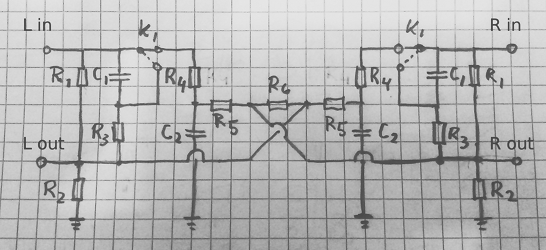castleofargh
Sound Science Forum Moderator
- Joined
- Jul 2, 2011
- Posts
- 10,965
- Likes
- 6,790
my timid attempts at playing with mid/side was really not worth the effort. can't say it's wrong or bad in general, only that it was in my hands ^_^.
I thought about applying an EQ to the middle signal so that I would perceive the singer in front of me, not up or down. and then try different options to make something that would still retain channel separation with the rest and apply some close enough HRTF profile for 30° speakers.
most attempts ended in clear mistakes from me being too ignorant. and getting delays and/or level issues have indeed been some of the issues, that and having the same instrument at 2 places at once in my mind when failing to completely filter it out of the mid channel... all clearly noob mistakes, and I went for most of them.
soon enough I was thinking something well known to people with no willpower and no achievement, "F it, I give up!". and since I've been waiting for the realiser A16(typical lack of brain compensated with money). what I use ATM is to simply apply the HRTF impulses for 30° with a true stereo convolver. it gives marginally better results than Xnor's crossfeed with settings for my big empty head, but it was such a pain just to try a bunch of HRTF impulses one after the other until one felt ok for my subjective image of instrument placements. if I was to start from scratch again, I'd enjoy basic crossfeed while eating pringles instead.
I thought about applying an EQ to the middle signal so that I would perceive the singer in front of me, not up or down. and then try different options to make something that would still retain channel separation with the rest and apply some close enough HRTF profile for 30° speakers.
most attempts ended in clear mistakes from me being too ignorant. and getting delays and/or level issues have indeed been some of the issues, that and having the same instrument at 2 places at once in my mind when failing to completely filter it out of the mid channel... all clearly noob mistakes, and I went for most of them.
soon enough I was thinking something well known to people with no willpower and no achievement, "F it, I give up!". and since I've been waiting for the realiser A16(typical lack of brain compensated with money). what I use ATM is to simply apply the HRTF impulses for 30° with a true stereo convolver. it gives marginally better results than Xnor's crossfeed with settings for my big empty head, but it was such a pain just to try a bunch of HRTF impulses one after the other until one felt ok for my subjective image of instrument placements. if I was to start from scratch again, I'd enjoy basic crossfeed while eating pringles instead.





















